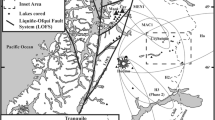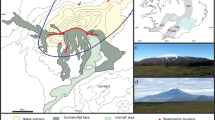Abstract
The tephra fallout from the 12–15 August 1991 explosive eruption of Hudson volcano (Cordillera de los Andes, 45°54′ S-72°58′ W; Chile) was dispersed on a narrow, elongated ESE sector of Patagonia, covering an area (on land) of more than 100 000 km2. The elongated shape of the deposit, together with the relatively coarse mean and median values of the particles at a considerable distance from the vent, were the result of strong winds blowing to the southeast during the eruption. The thickness of the fall deposit decreases up to 250 km ESE from Hudson volcano, where it begins to thicken again. Secondary maxima are well developed at approximately 500 km from the vent. Secondary maxima, together with grainsize bimodality in individual layers and in the bulk deposit suggest that particle aggregation played an important role in tephra sedimentation. The fallout deposit is well stratified, with alternating fine-grained and coarsegrained layers, which is probably a result of strong eruptive pulses followed by relatively calm periods and/or changes in the eruptive style from plinian to phreatoplinian. The tephra is mostly composed of juvenile material: the coarse mode (mostly pumice) shifts to finer sizes with distance from the volcano; the fine mode (mostly glass shards) is always about 5/6 phi. Glass shards and pumice are mostly light gray to colorless. However, considerable amounts of dark, poorly vesiculated, blocky shards, suggest a hydromagmatic component in the eruption. A land-based tephra volume of 4.35 km3 was estimated, and a total volume of 7.6 km3 arose from an extrapolation, which took into account the probable volume sedimented in the sea. Bulk density ranges from 0.9 to 1.10 gr/cm3 (beyond 110 km from the vent). Rather uniform density values measured in crushed samples (2.45–2.50 gr/cm3 at all distances from the vent) reveal a relatively homogeneous composition. Mean and median sizes decrease rapidly up to 270 km from the vent; beyond that point they are more or less constant, whereas the maximum size (1 phi) shows a steady decrease up to 550 km. A concomitant improvement in sorting is observed. This is attributed to sorting due to wind transport combined with particle aggregation at different times and distances from the vent. The Hudson tephra fallout shares some strikingly similar features with the Mount St. Helens (18 May 1980) and Quizapu (1932) eruptions.
Similar content being viewed by others
References
Arias N, Arizmendi A, Bitschene P, Fernández M, Giacosa R, Grizinik M, Márquez M, Nillni A (1992) La erupción del volcán Hudson y sus efectos inmediatos en la Patagonia argentina (Provincia de Santa Cruz). Primera Reunión Argentina de Mineralogía y Metalogenia Actas:9–18
Banks NG, Iven M (1991) Report of the United Nations Mission to Volcán Hudson, Chile, 20 August–15 September 1991. Report, US Geol Surv, Cascades Volcano Observatory, pp 1–61
Bitschene P, Arias N, Arizmendi A, Fernández M, Giacosa R, Grizinik M, Márquez M, Nillni A (1992) The Hudson eruption of August 1991: petrology, ash fall, characteristics and natural disaster assessment. Actas del Octavo Congreso Latinoamericano de Geología 4:209–212. Salamanca, España
Brazier S, Sparks RSJ, Carey S, Sigurdsson H, Westgate JA (1983) Bimodal grain size distribution and secondary thickening in airfall ash layers. Nature 301:115–119
Carey S, Sigurdsson H (1982) Influence of particle aggregation on deposition of distal tephra from May 18, 1980 eruption of Mount St. Helens volcano. J Geophys Res 87:7061–7072
Carey S, Sigurdsson H, Gardner JE, Criswell W (1990) Variations in column height and magma discharge during the May 18, 1980 eruption of Mount St. Helens. J Volcanol Geotherm Res 43:99–112
Corbella H, Scasso RA, Lucero M, Palacios ME, Tiberi PE, Rial P, Perez D (1991a) Erupción del Volcán Hudson-Agosto de 1991. Efectos sobre el territorio de la Provincia de Santa Cruz. Publicación científica de la Universidad Federal de la Patagonia Austral, Waxen 4:1–15
Corbella H, Scasso RA, Rial P, Palacios ME, Lucero M, Tiberi PE, Pérez D (1991b) Hudson. Bull Global Volcanism Network 16(9):2–3
Corbella H, Gagliardini A, Leis J (1991c) Análisis de los penachos eruptivos del volcán Hudson sobre la Patagonia argentina, Agosto 1991, según imágenes NOAA-AVHRR. V Simposio Latinoamericano de Percepción Remota. SELPER. Cuzco, Perú. Abstract
Destéfano MC, Mazzoni MM (1992) Textura superficial y composición de trizas vítreas de la erupción 1991 del volcán Hudson. Cuarta Reunión Argentina de Sedimentología 1:211–218
Fierstein J, Nathenson M (1992) Another look at the calculation of fallout tephra volumes. Bull Volcanol 54:156–167
Fisher RV (1964) Maximum size, median diameter and sorting of tephra. J Geophys Res 69:341–355
Fisher RV, Schmincke HU (1984) Pyroclastic rocks. Springer-Verlag, Berlin, Heidelberg, New York, Tokyo, pp 1–471
Gagliardini DA, Corbella H, Leis J (1992) Contribution of NOAA-AVHRR data to study the August 1991 Hudson volcano eruption. European International Space Year. Group 4: Remote sensing for environmental monitoring and research management. Session Natural Hazards and Disaster Mitigation. Munich, Germany. Abstract
Gilbert JS, Lane SJ, Sparks RSJ (1991a) Particle aggregation controlled by electrical charge in volcanic plumes. US Geol Surv Abstracts, Circular 1065:20
Gilbert JS, Lane SJ, Sparks RSJ, Koyaguchi T (1991b) Charge measurements on particle fallout from a volcanic plume. Nature 349:598–600
Hildreth W, Drake RE (1992) Volcán Quizapu, Chilean Andes. Bull Volcanol 54:93–125
Kittl E (1933) Estudio sobre los fenómenos volcánicos y el material caído durante la erupción del Grupo del “Descabezado” en el mes de abril de 1932. Anales del Museo Nacional de Historia Natural, Buenos Aires 37:321–364
Krumbein WC, Pettijohn FJ (1938) Manual of sedimentary petrography. Appleton-Century-Crofts, New York, London, pp 1–549
Larsson W (1937) Vulkanische Asche vom Ausbruch des chilenischen Vulkans Quizapu (1932) in Argentinien gesammelt. Eine Studie über äolische Differentiation. Geologisches Institut Upsala Bulletin 26:27–52
Mazzoni MM, Destéfano MC (1992) Depositación sineruptiva y reelaboración temprana. Depósitos de caída de ceniza de la erupción 1991 del volcán Hudson. Cuarta Reunión Argentina de Sedimentología Actas 1:203–210 La Plata
Naranjo J (1991) Major eruption reported in Chile. EOS Trans Am Geophys Union 72:393–394
Newhall CG, Self S (1982) The volcanic explosivity index (VEI): an estimate of explosive magnitude for historical volcanism. J Geophys Res 87:1231–1238
Nillni A, Fernández M, Arizmendi A, Arias N, Rodríguez M, Bitschene P (1992) Volcán Hudson: estudio granulométrico y composicional del material piroclástico eyectado. Cuarta Reunión Argentina de Sedimentología Actas 3:73–80. La Plata
Pyle DM (1989) The thickness, volume and grain size of tephra fall deposits. Bull Volcanol 51:1–15
Sarna-Wojicki AM, Shipley S, Waitt R Jr, Dzurisin D, Wood S (1982) Areal distribution, thickness, mass, volume and grainsize of air-fall ash from six major eruptions of 1980. US Geol Surv Prof Pap 1250:577–600
Sparks RSJ, Huang TC (1980) The volcanological significance of deep-sea ash layers associated with ignimbrites. Geol Mag 117:425–436
Walker GPL (1981) Plinian eruptions and their deposits. Bull Volcanol 44:223–240
Wilson L, Huang TC (1979) The influence of shape on the atmospheric settling velocity of volcanic ash particles. Earth Planet Sci Lett 44:311–324
Author information
Authors and Affiliations
Rights and permissions
About this article
Cite this article
Scasso, R.A., Corbella, H. & Tiberi, P. Sedimentological analysis of the tephra from the 12–15 August 1991 eruption of Hudson volcano. Bull Volcanol 56, 121–132 (1994). https://doi.org/10.1007/BF00304107
Received:
Accepted:
Issue Date:
DOI: https://doi.org/10.1007/BF00304107




